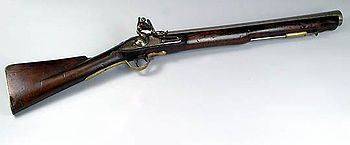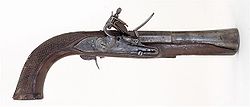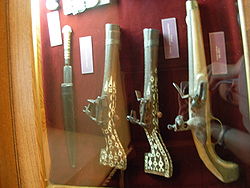- Blunderbuss
-
For the EP, see Blunderbuss (EP). For the Cornish giant, see Blunderbore.
The blunderbuss is a muzzle-loading firearm with a short, large caliber barrel, which is flared at the muzzle and frequently throughout the entire bore, and used with shot and other projectiles of relevant quantity and/or caliber. The blunderbuss could be considered to be an early form of shotgun, which was often adapted to military and defensive use.[1] The term dragon was used to describe a blunderbuss in handgun form, and it is from this that the term dragoon evolved.[2][3]
Contents
Etymology
 A flintlock blunderbuss, built for Tippu Sultan in Seringapatam, 1793–1794. Tippu Sultan used many Western craftsmen, and this gun reflects the most up-to-date technologies of the time.[4]
A flintlock blunderbuss, built for Tippu Sultan in Seringapatam, 1793–1794. Tippu Sultan used many Western craftsmen, and this gun reflects the most up-to-date technologies of the time.[4]
The term "blunderbuss" is of Dutch origin, from the Dutch word donderbus, which is a combination of donder, meaning "thunder", and buss, meaning "Pipe" (Middle Dutch: busse, box, tube, from Late Latin, buxis, box).[1]
The transition from donder to blunder is thought by some to be deliberate; the term blunder was originally used in a transitive sense, synonymous with to confuse, and this is thought to describe the stunningly loud report of the large bore, short barreled blunderbuss.[2] The term dragon is taken from the fact that early versions were decorated with a carving in the form of a mythical dragon's head around the muzzle; the muzzle blast would then give the impression of a fire breathing dragon.[3]
Construction
The blunderbuss could be considered an early shotgun, and served in similar roles. While various ancient accounts often list the blunderbuss as being loaded with various scrap iron, rocks, or wood this would result in damage to the bore of the gun; it was typically loaded with a number of lead balls smaller than the bore diameter. Barrels could be made of steel or brass.
The muzzle (and often the bore) was flared with the intent not only to increase the spread of the shot, but also to funnel powder and shot into the weapon, making it easier to reload on horseback or on a moving carriage; however, modern experiments have shown that the flared muzzle has no noticeable effect on shot spread. The flared muzzle is the defining feature of the blunderbuss, differentiating it from large caliber carbines; the distinction between the blunderbuss and the musketoon is less distinct, as musketoons were also used with shot, and some had flared barrels.[5][6][7] Blunderbusses were typically very short, with barrels under two feet (60 cm) in length, at a time when a typical musket barrel was over three feet (90 cm) long.[8][9] One source, describing arms from the early to middle 17th century, lists the barrel length of a wheel lock dragon is around eleven inches (28 cm), compared to a sixteen inch (41 cm) length for a blunderbuss.[2]
Use
A pair of early blunderbuss pistols from Poland fitted with the miquelet lock
The blunderbuss, and especially the shorter dragon, was typically issued to troops such as cavalry, who needed a lightweight, easily handled firearm.[9] The dragon became so associated with cavalry and mounted infantry that the term dragoon became synonymous with mounted infantry. In addition to the cavalry, the blunderbuss found use for other duties in which the shotgun-like qualities were desirable, such as for guarding prisoners or defending a mail coach, and its use for urban combat was also recognized.[3][10] Blunderbusses were also commonly carried by naval warships, privateers and pirates for use in close-quarters boarding actions.[11] The Portuguese marines used it widely in the 17th century.
The blunderbuss used by the British mail service during the period of 1788–1816 was a flintlock with a 14 inch long flared brass barrel, brass trigger guard, and iron trigger and lock. A typical British mail coach would have a single postal employee on board, armed with a blunderbuss and a pair of pistols, to guard the mail from highwaymen.[12] One 18th century coaching blunderbuss in another British collection had a brass barrel 17 inches long, flaring to 2 inches at the muzzle; it was also provided with a spring-loaded bayonet, which was held along the barrel by a catch and would spring forward into place when released.[7]
While the blunderbuss is often associated with the Plymouth Colony Pilgrims,[13] evidence suggests that the blunderbuss was relatively scarce in the American colonies. After the Battle of Lexington, British General Thomas Gage occupied Boston, Massachusetts. After negotiating with the town committee, Gage agreed to let the inhabitants of Boston leave town with their families and effects, if they surrendered all arms. While most of the residents of Boston stayed, those who left under the agreement surrendered 1778 firearms, 634 pistols, 273 bayonets, and only 38 blunderbusses.[14] The blunderbuss did still have its civilian applications, however; the Lewis and Clark Expedition carried a number of blunderbusses, some of which were mounted and used as small swivel guns on the pirogues.[6]
By the middle 19th century, the blunderbuss was considered obsolete. The blunderbuss was replaced in military use by the carbine, though the latter was considered by some to be a poor replacement, though the blunderbuss still found use with civilians as a defensive firearm.[15][16] (The carbine in use by the British during the Crimean War was lampooned in Punch magazine as being able, in the hands of a good shot, to "hit a hayrick at 80 yards".
See also
References
- Notes
- ^ a b
 Chisholm, Hugh, ed (1911). "Blunderbuss". Encyclopædia Britannica (11th ed.). Cambridge University Press.
Chisholm, Hugh, ed (1911). "Blunderbuss". Encyclopædia Britannica (11th ed.). Cambridge University Press. - ^ a b c Sibbald Mike Lier (1868). The British Army: Its Origin, Progress, and Equipment. Cassell, Petter, Galpin. p. 33, 302–304.
- ^ a b c George Elliot Voyle, G. de Saint-Clair-Stevenson (1876). A Military Dictionary. W. Clowes & Sons. p. 43, 114.
- ^ Exhibition at the Metropolitan Museum of Art, your New York.
- ^ "Musketoon (AAA2517)". National Maritime Museum. http://www.nmm.ac.uk/collections/explore/object.cfm?ID=AAA2517.
- ^ a b "Thunder Gun". http://www.lewis-clark.org/content/content-article.asp?ArticleID=2360.
- ^ a b Society of Antiquaries of Newcastle upon Tyne (1905). Proceedings. Society of Antiquaries of Newcastle-upon-Tyne. p. 251.
- ^ See Brown Bess.
- ^ a b Charles Francis Hoban (1853). Pennsylvania Archives., page 324, from a letter dated March 7, 1778
- ^ George Otto Trevelyan (1905). The American Revolution. Longmans, Green and co..
- ^ http://www.gunclassics.com/pirateblunder.html
- ^ The British Postal Museum and Archive. "Weapons". http://postalheritage.org.uk/collections/museum/weapons/., see items OB1995.338 and OB1995.344
- ^ Archie Frederick Collins (1917). Shooting: For Boys. Moffat, Yard and company. pp. 33–34.
- ^ Abiel Holmes (1829). The Annals of America, Volume II. Hillard and Brown. p. 242.
- ^ Edward Henry Knight (1876). Knight's American Mechanical Dictionary. Hurd and Houghton.
- ^ Henry Mayhew (1855). Punch. XXVIII.Number 704, page 2
Categories:- Muskets
- Early firearms
- 18th-century weapons
- 19th-century weapons
Wikimedia Foundation. 2010.





